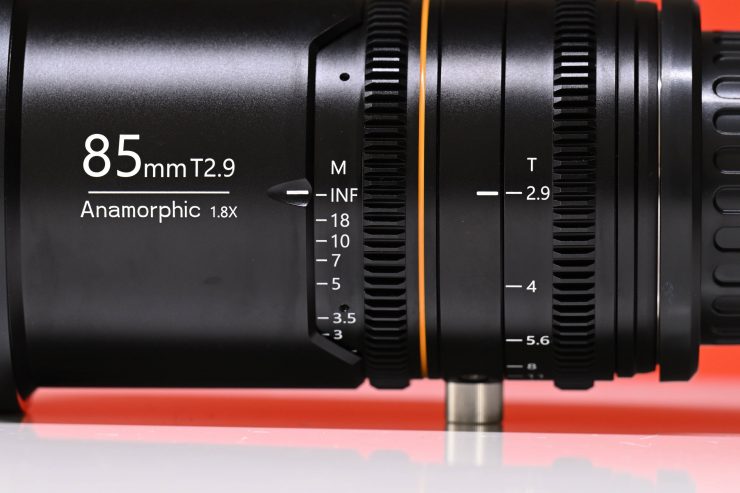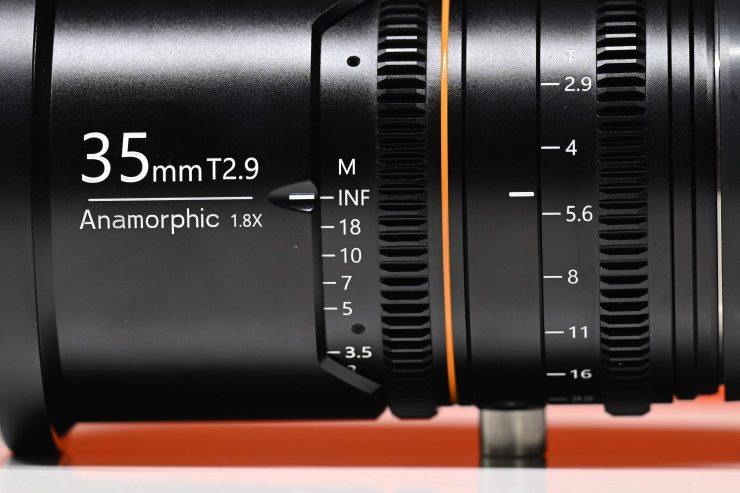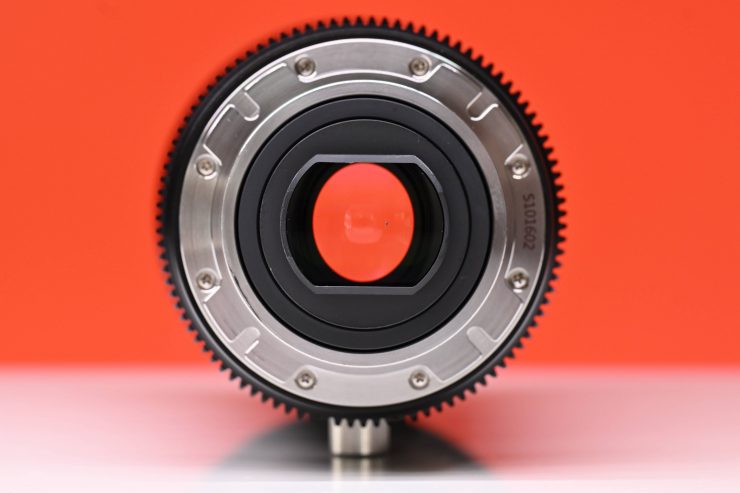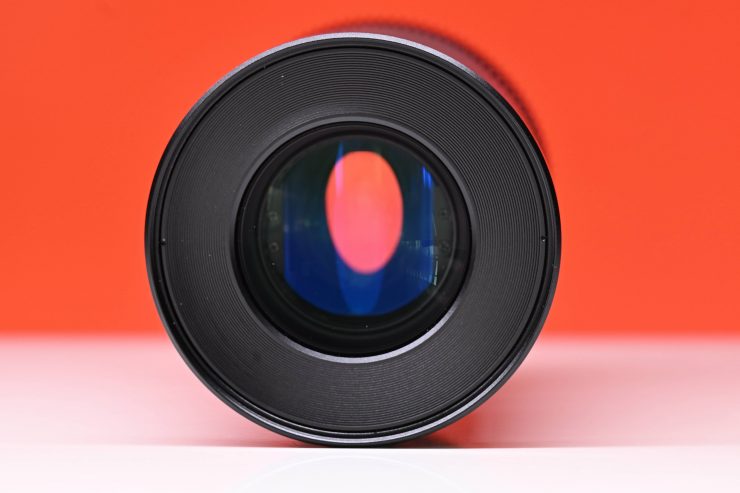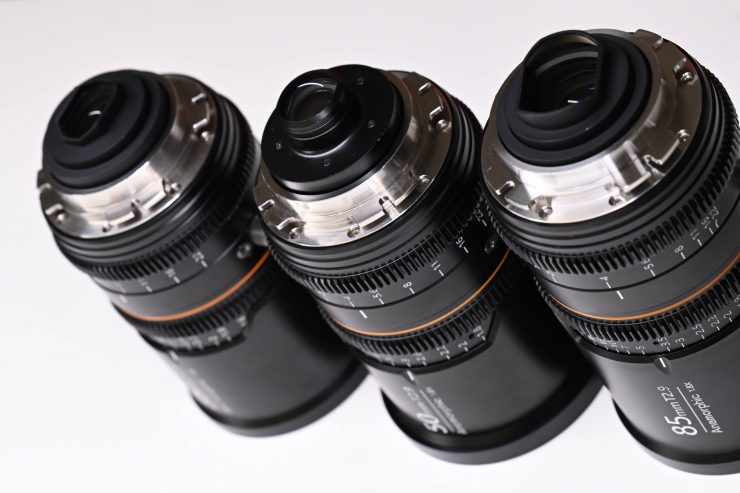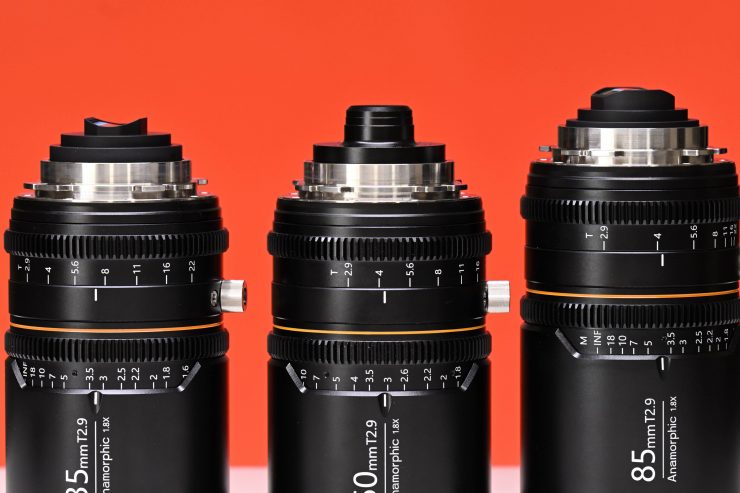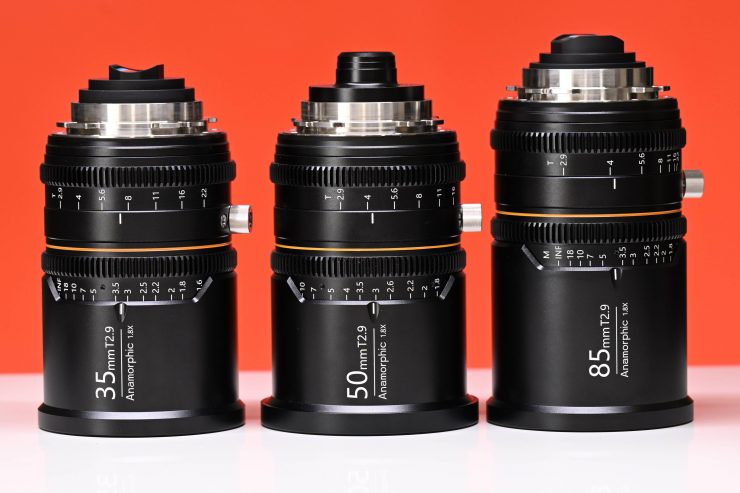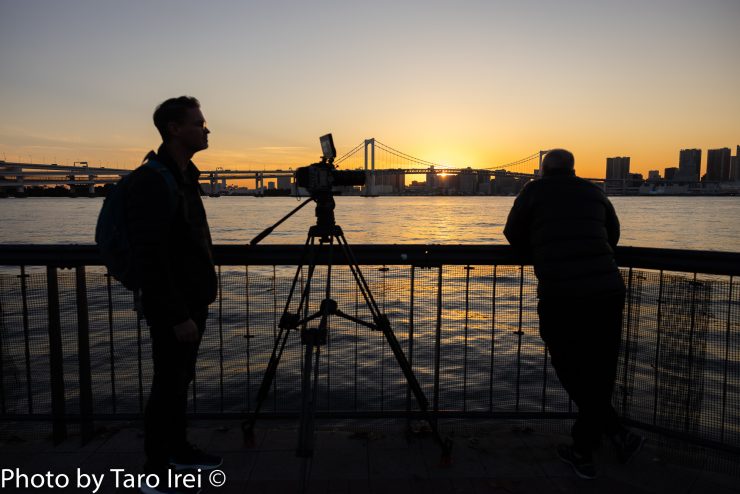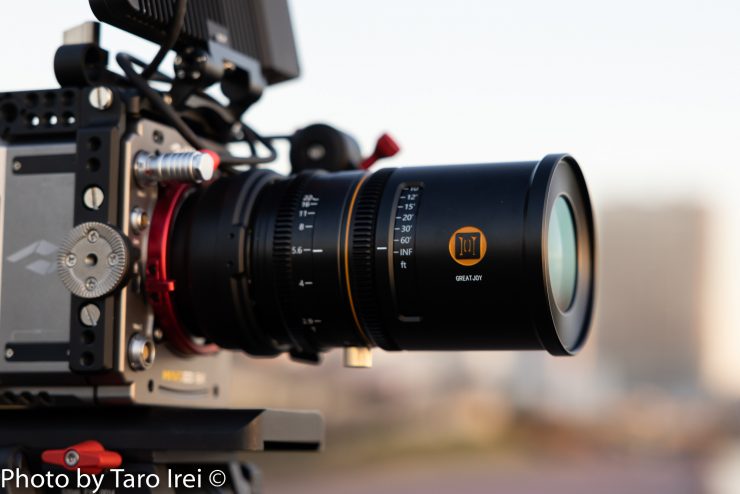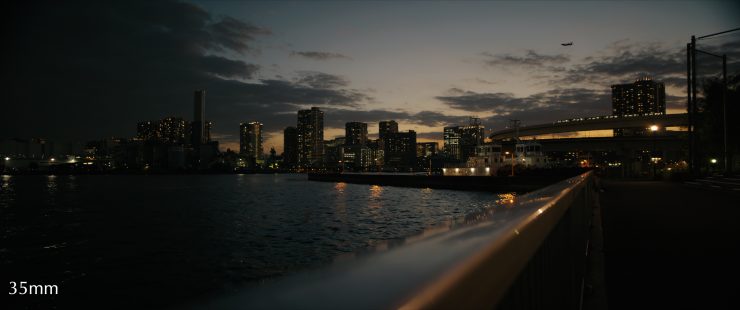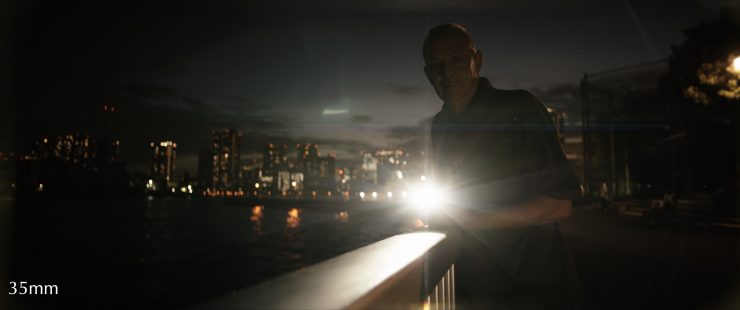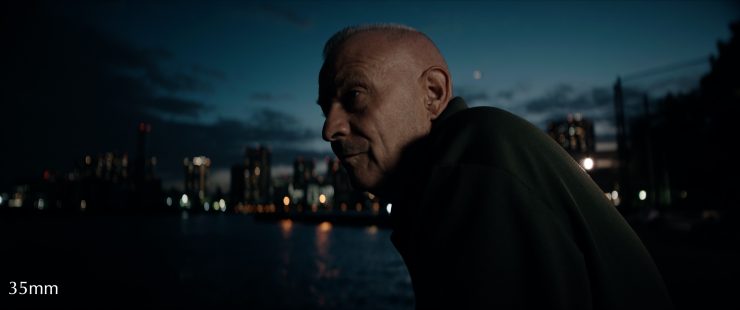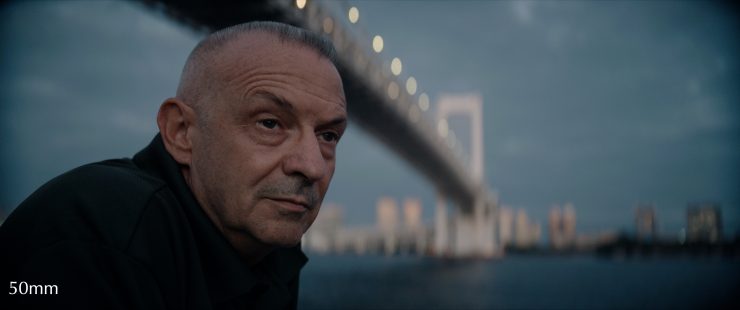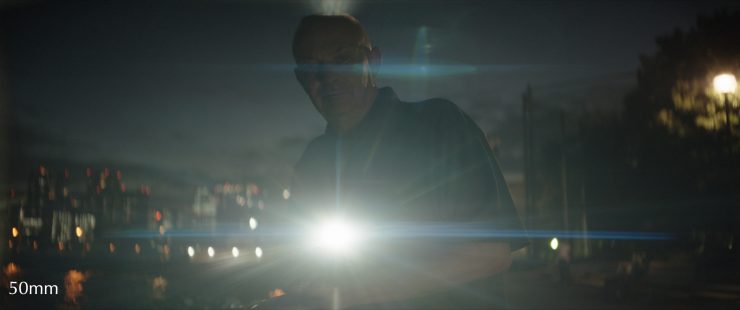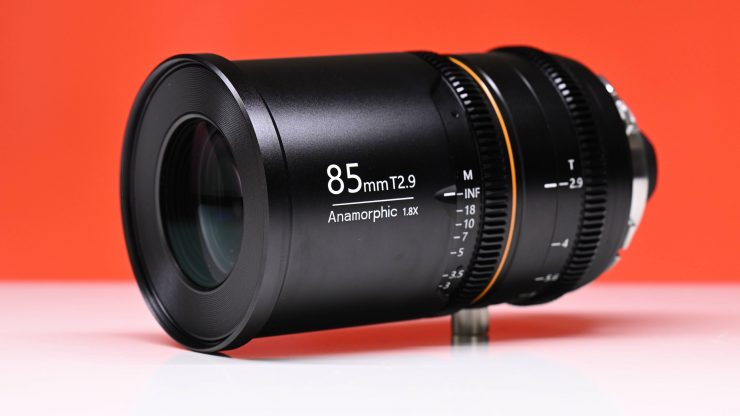
The Great Joy 85mm T2.9 1.8x Anamorphic Lens is the third full frame 1.8x offering in the series and it now joins the 35mm and 50mm T2.9 1.8x that I have both previously reviewed on the site. Just like the 35mm, the 85mm is not a rear anamorphic.
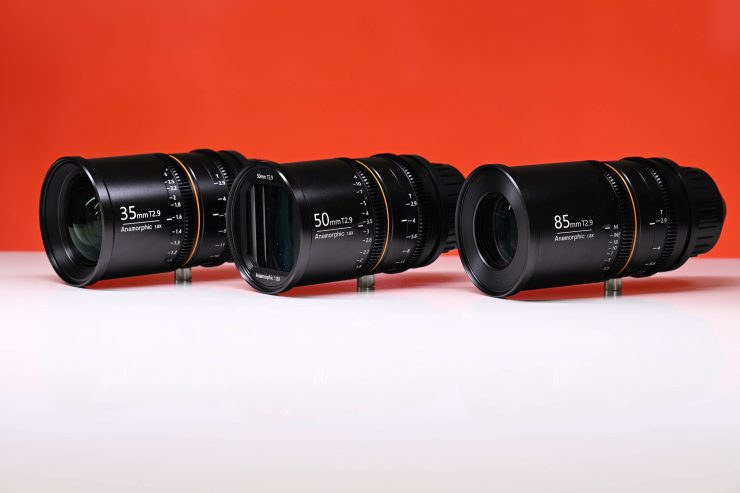
I was impressed with both the 35 and 50mm lenses given their relatively low price. With three focal lengths now available, Great Joy offers a reasonably decent focal range that won’t cost you a lot of money.
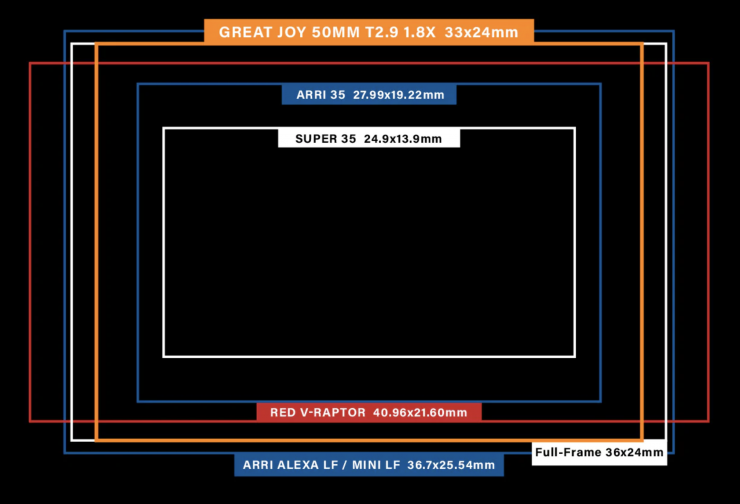
All three lenses cover a 33 x 24 mm image circle. If you are shooting open gate 4:3 you should be able to get a 2.4:1 image without any vignetting on a camera with a full-frame sensor.
Yes, there is vignetting when shooting open gate on certain cameras, but if you are cropping to get a 2.39:1 aspect ratio then it should be minimal depending on the focal length you are using.
Concept
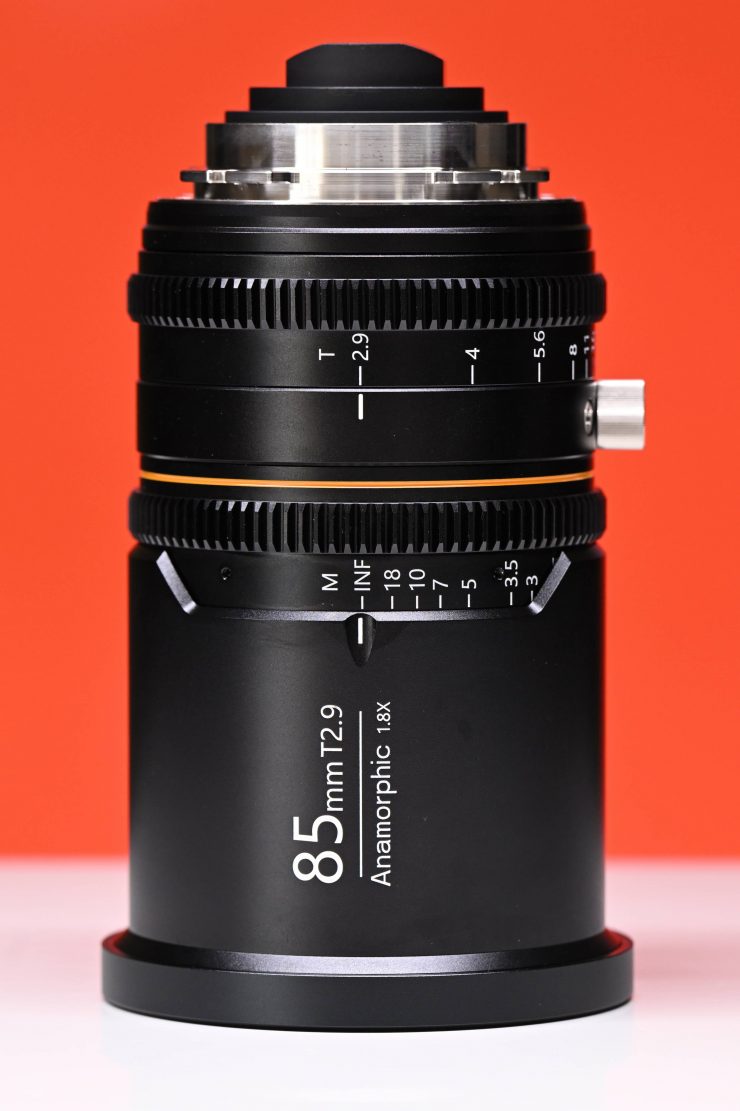
The concept behind the 35mm, 50mm and 85mm 1.8x T2.9 was to make an affordable series of full-frame anamorphic lenses for the masses. Most anamorphic lenses, especially those that cover full-frame are expensive. Great Joy bucks this trend and the price almost makes it sound too good to be true.
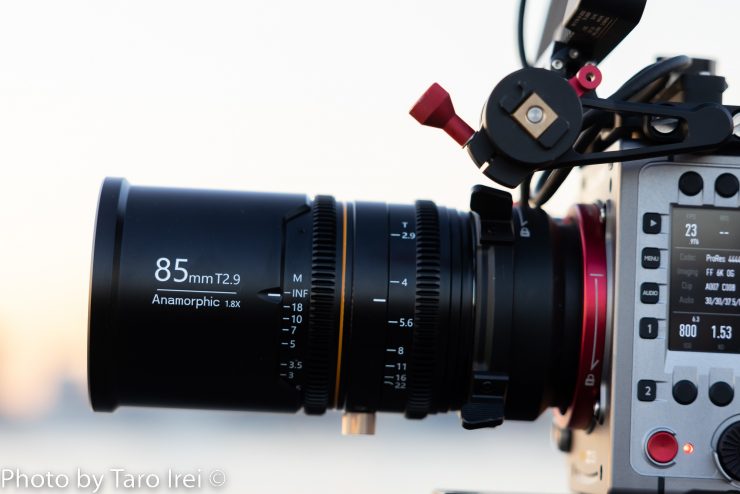
Great Joy is also going to release a 135mm so there will be four lenses in the series. This means that you don’t have to worry about buying a lens and then wondering if any more focal lengths will appear. I would imagine that if these lenses prove to be popular then there may well be other focal lengths available in the future to further expand the set past four lenses.
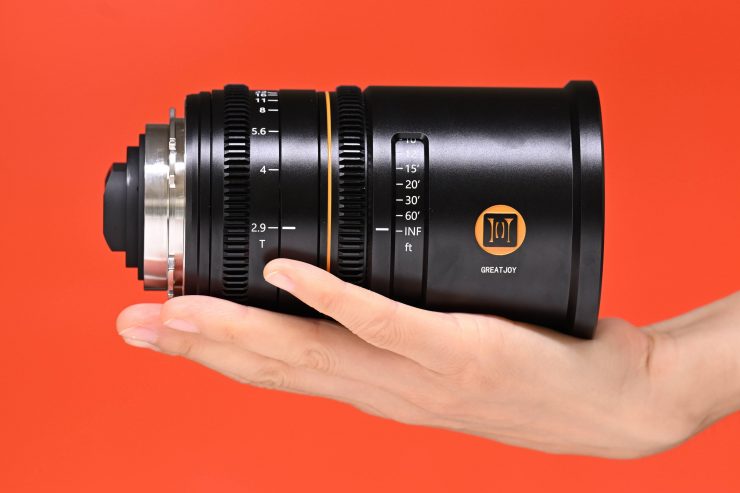
I think it would be fair to say that Great Joy is trying to attract owner/operators of mid-tier and lower-cost digital cinema cameras and mirrorless hybrids that are capable of shooting in open-gate anamorphic modes. In saying that, they could also very well find themselves on more expensive cameras as well.
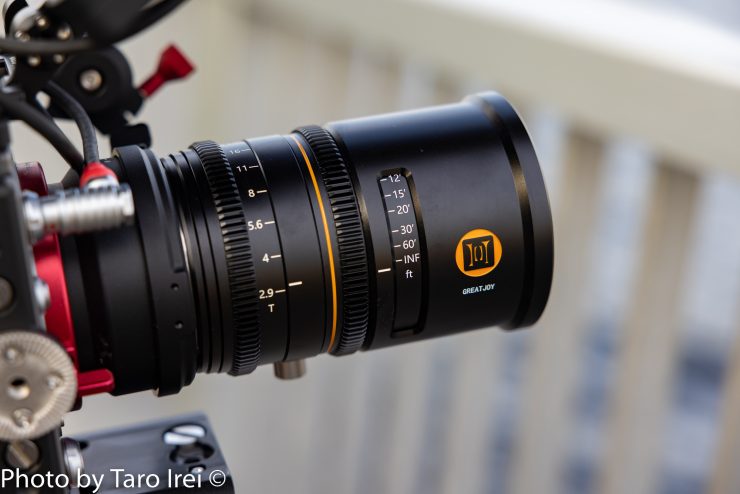
At under $1,500 USD you can absolutely classify this lens as affordable. In the full-frame anamorphic space, these Great Joy lenses are a lot more affordable than other options that are available. To put the price in perspective, the Vazen 1.8x anamorphic lenses cost $8,000 USD each.
Size & Weight
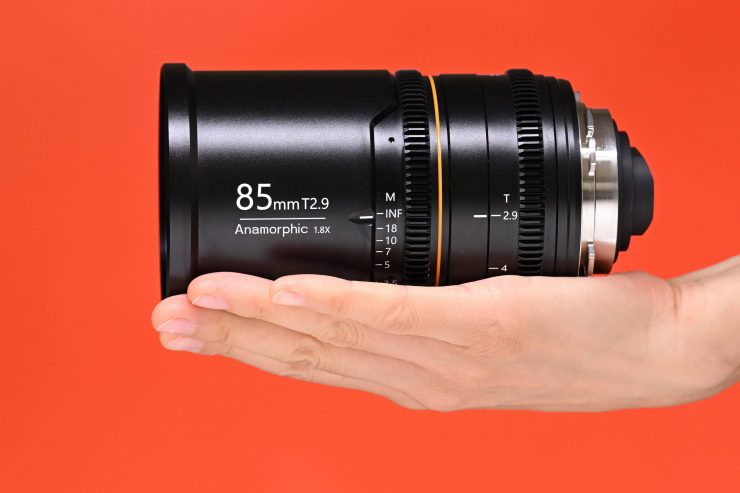
The 85mm 1.8X anamorphic lens features a reasonably compact and lightweight design. It tips the scales at 1.18kg / 2.60 lbs (PL mount version), which makes it slightly heavier than the 50mm T2.9 and about the same weight as the 35mm.
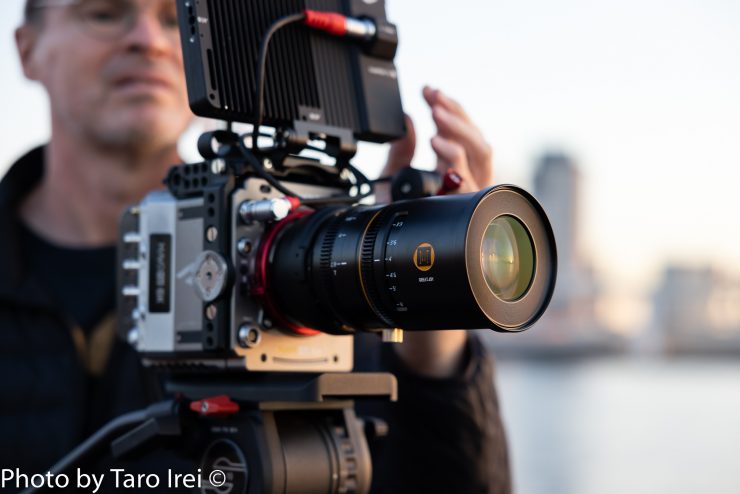
The idea behind keeping the size and weight to a minimum was so that the lenses could be balanced on gimbals and other stabilized platforms. By keeping it light and small it also works well on small-sized digital cinema cameras.
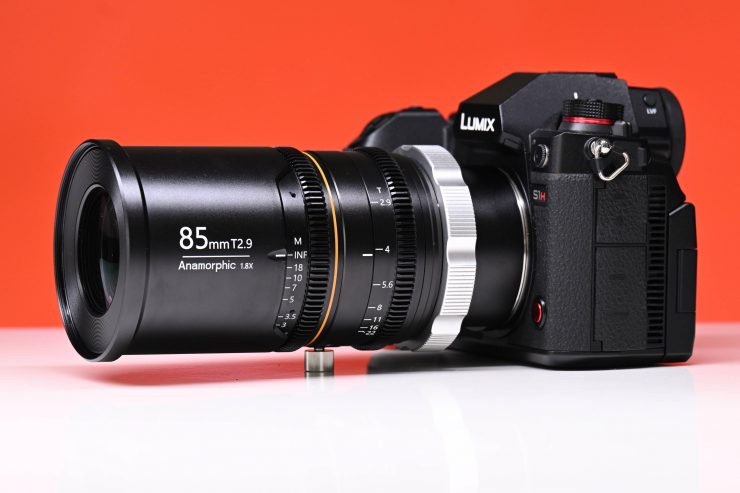
You may well find that the lens is a little heavy if you are putting it on a smaller-sized camera such as a mirrorless hybrid, but I thought it was easily manageable on those types of cameras.
Build Quality
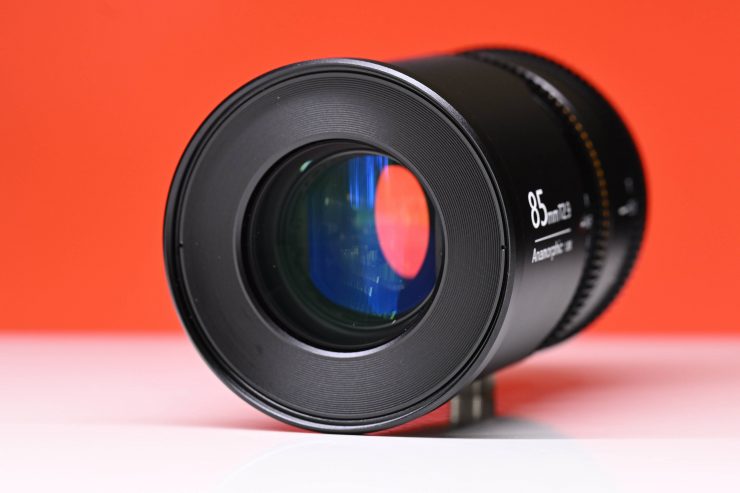
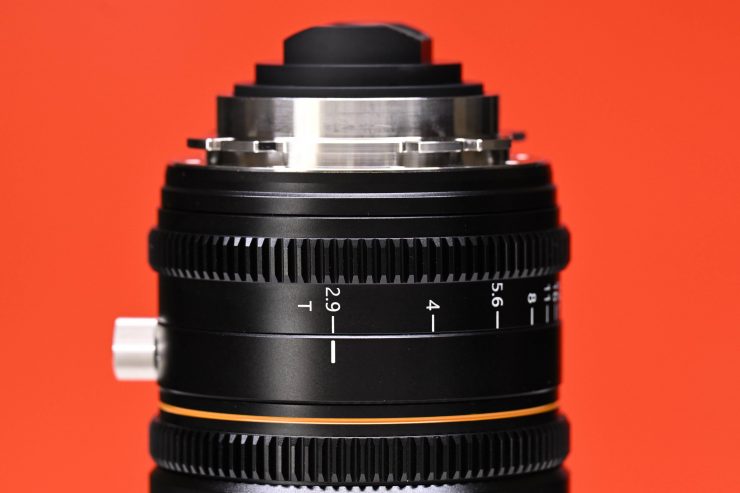
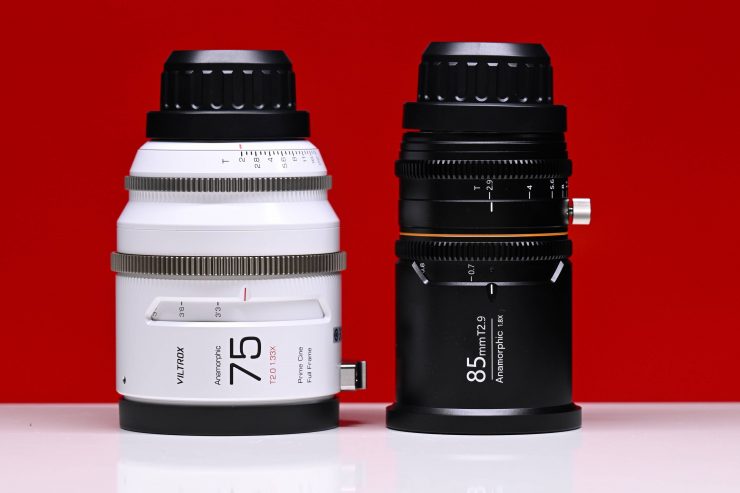
Viltrox T2 1.33x Anamorphic lens on the left & the Great Joy 85mm T2.9 1.8x on the right
The lens is reasonably well made, but the build quality isn’t going to rival a Cooke, ARRI, Zeiss, or Angenieux, nor would I expect it to. I would say that the build quality is reasonably comparable to the Vazen 1.8x full-frame anamorphic lenses, but it is not nearly as good as the Viltrox T2 1.33x Anamorphic lenses that I just recently reviewed. The lens housing is made out of metal and it feels solid to the touch.
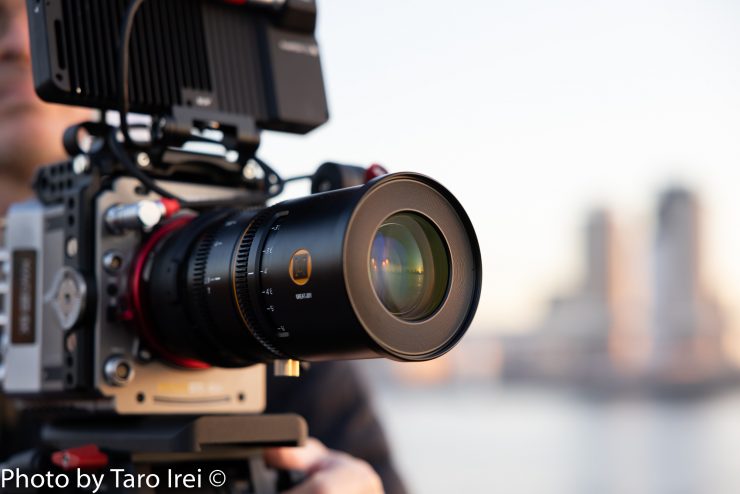
I like that Great Joy went with a fairly understated design with their lenses and they don’t draw attention to themselves.
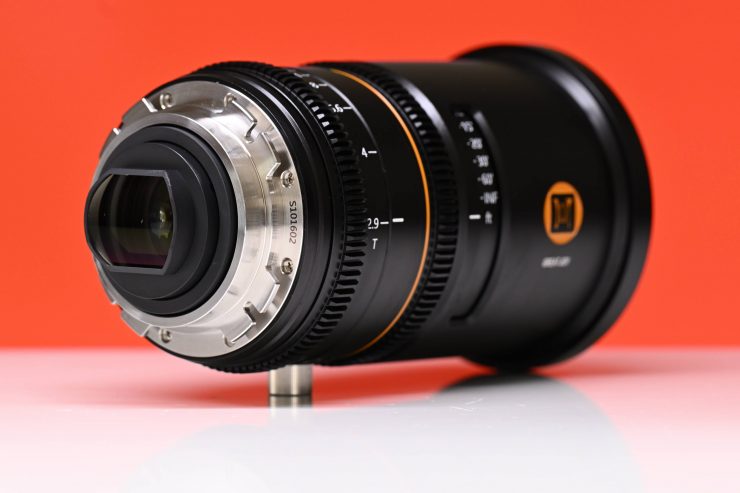
What I was interested to find out is how the build quality of the 85mm compared to the 35mm and 50mm.
With the 50mm the aperture ring didn’t have a lot of resistance and I found it to be a little loose for my liking. The focus ring resistance also wasn’t consistent. The lens had less resistance as you move from its minimum focusing distance to infinity. Conversely, when you are moving from infinity towards the minimum focusing distance there is considerably more resistance. These may have been small complaints, but it was enough for me to notice and take note of.
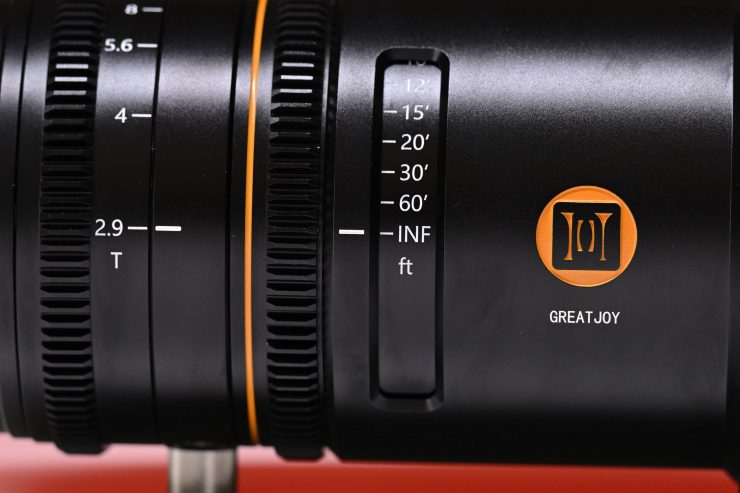
With the 35mm Great Joy addressed these issues. The aperture ring on the 85mm, just like the 35mm, has more resistance and it isn’t loose like on the 50mm. However, the 85mm has a stiffer aperture ring than the 35mm.
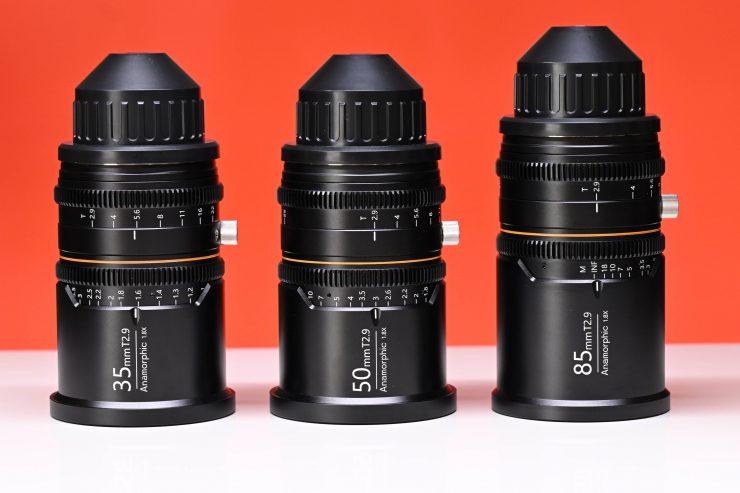
What I have found from testing all three of these lenses is that the build quality and mechanics aren’t consistent across the range. When you are buying different focal ranges in a set you want them all to have the exact same mechanics.
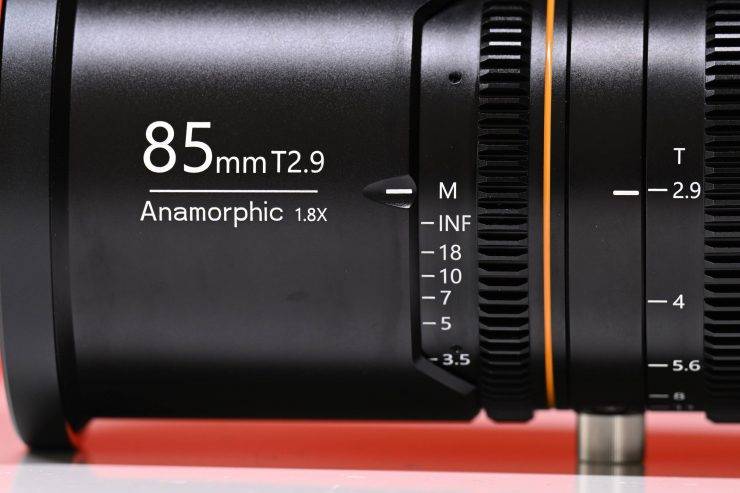
85mm 1.8x T2.9 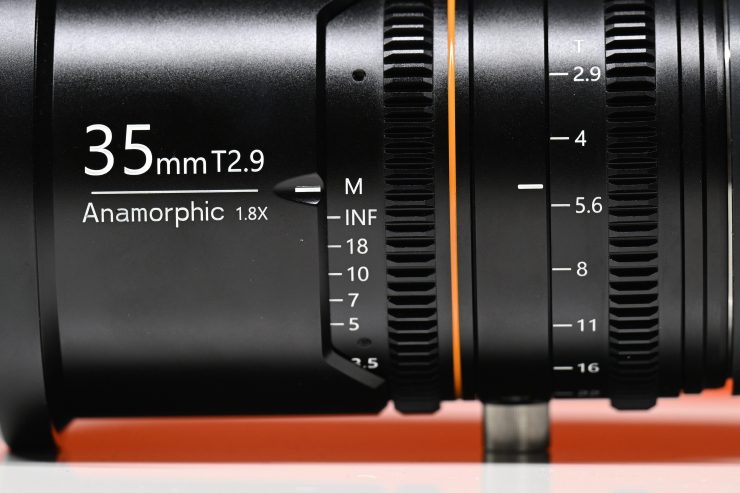
35mm 1.8x T2.9 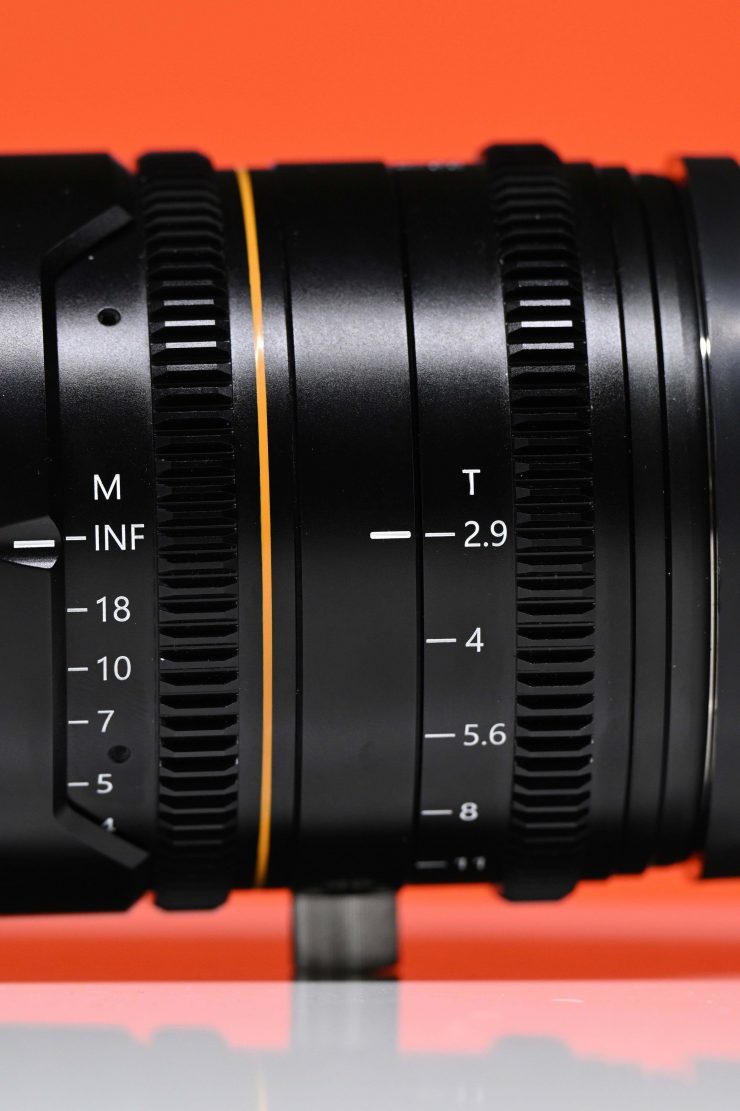
50mm 1.8x T2.9
Another issue that has been fixed with both the 85mm and 35mm, is that the focus travel now goes past infinity, instead of stopping right at infinity as it did with the 50mm. Speaking of the focus, the focus ring has a rotation of 238 degrees.
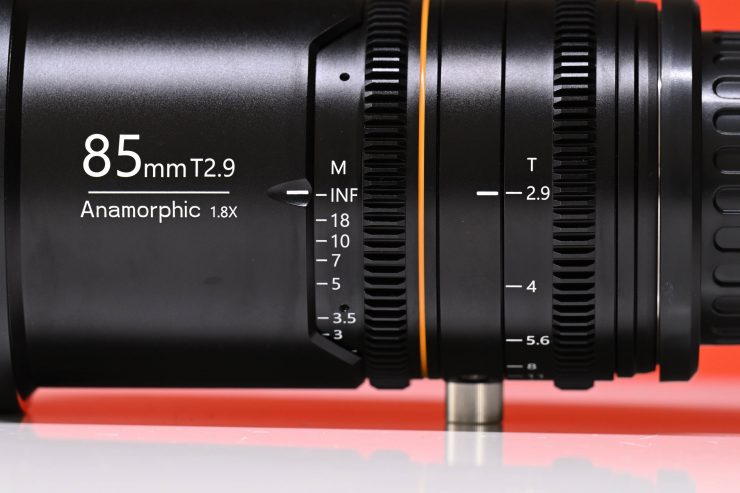
The other small issue I came across with the three focal lengths is that the pitch gears are quite recessed into the body of the lens. This does make the lenses slightly more tricky to use with focus motors.
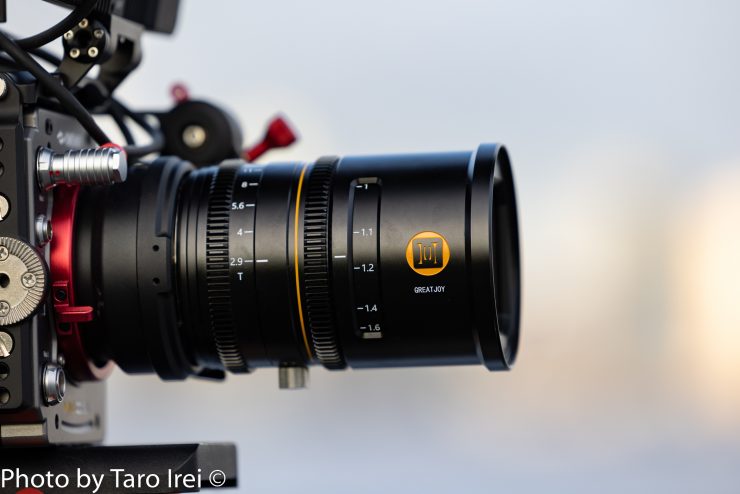
Attention to detail is still important, even if you are selling a lens for under $1,500 USD. Customers shouldn’t come across issues, especially with the operation or build quality. What always concerns me is that in a lot of cases with more affordable lenses, the consistency in terms of build quality and performance is not always the same from lens to lens and that seems to be the case with these offerings from Great Joy.
While I applaud Great Joy for making changes, if you already bought one of the first 50mm allotments then the build quality probably isn’t going to be consistent between that lens and the 85mm and 35mm. In saying that, I can only compare the lenses I have for this review. I have no way of knowing if this is the case for other lenses that were sold.
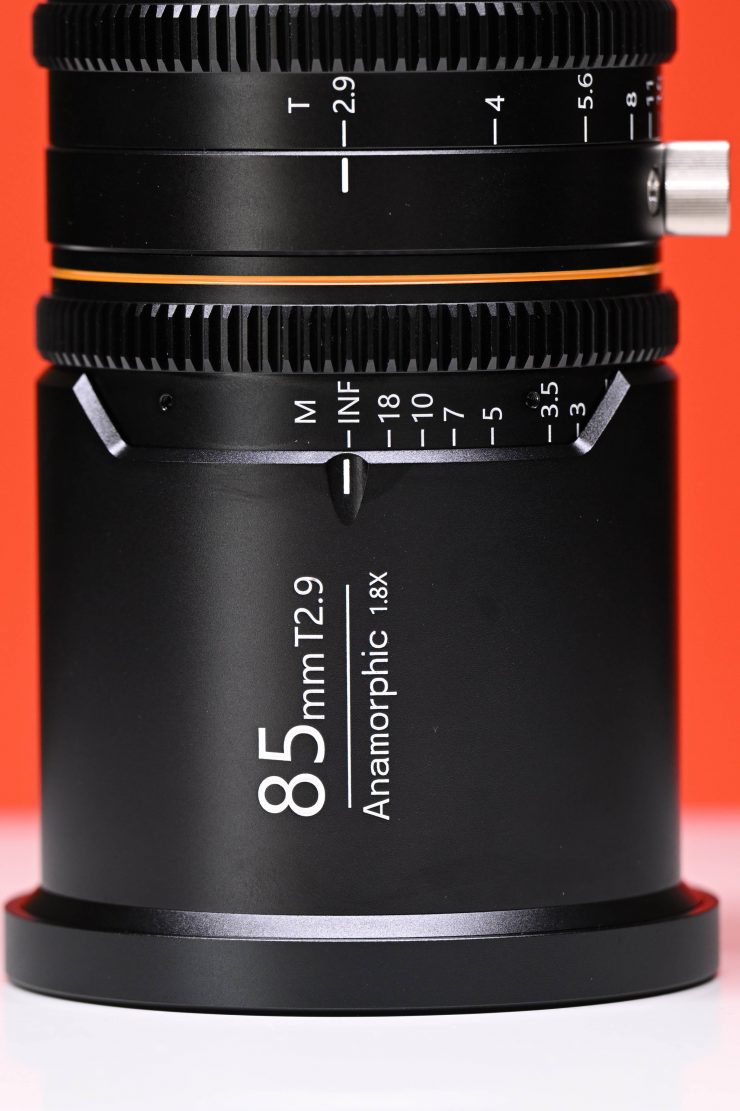
First impressions matter, especially for a relatively unknown company, and regardless of how good a lens actually performs, appearance and attention to detail will matter to a lot of potential customers.
Markings
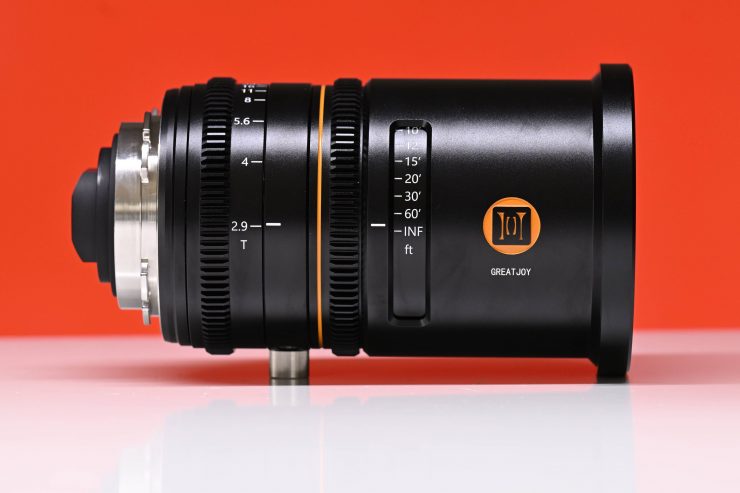
Great Joy 85mm T2.9 1.8x 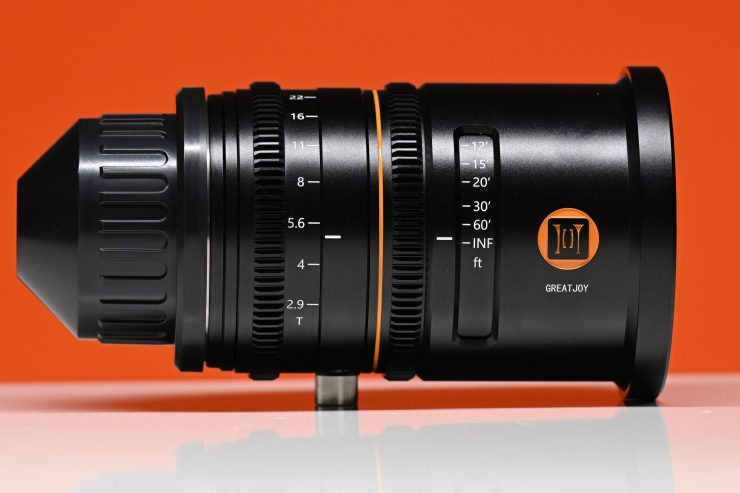
Great Joy 35mm T2.9 1.8x 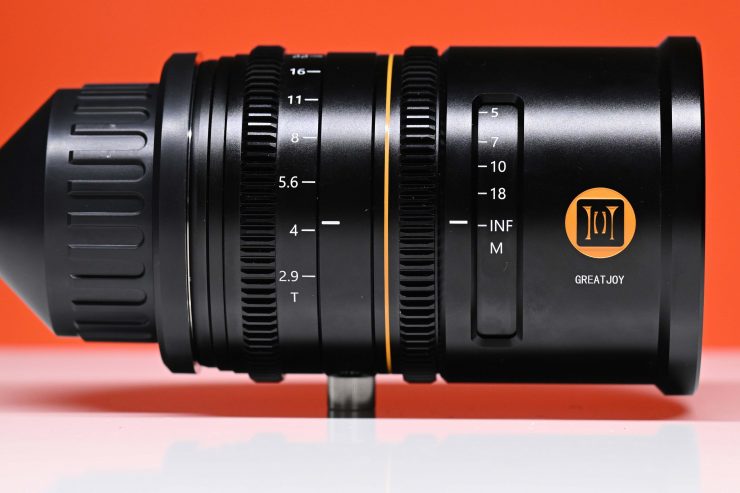
Great Joy 50mm T2.9 1.8x
The lens has decent markings for both aperture and focus. What I like is that they have actually placed physical marks next to the distances on the lens. The markings are consistent across the three lenses.
For a budget lens, it is nice to see markings for both the aperture and focus on the non-operators side of the lens.
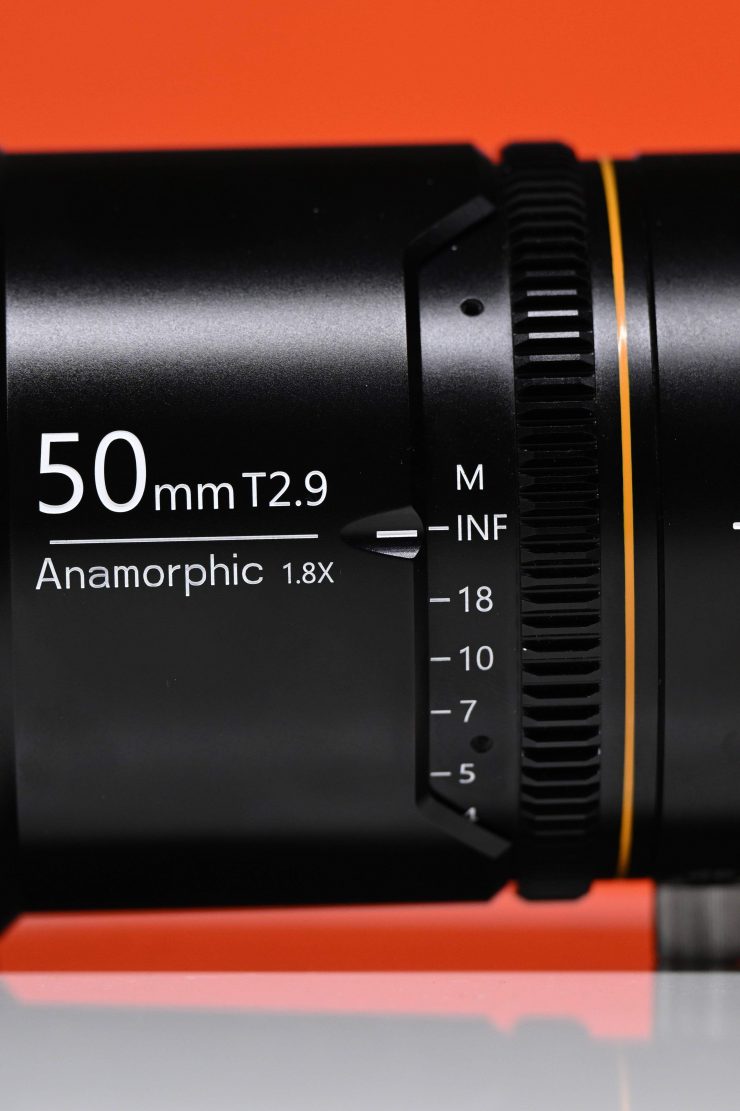
The only slight complaint I had with the 50mm when it comes to the markings is that the infinity marking didn’t line up correctly. This may be a small issue, but attention to detail is important.
On the 85mm and the 35mm, because the focus rotation actually goes past infinity, you can line up infinity correctly.
Other Features
The lens is designed with an 82mm front filter thread for attaching filters or diopters. The front diameter is a standard 95mm for matte box mounting. This is the same as the 35mm and 50mm 1.8x T2.9.
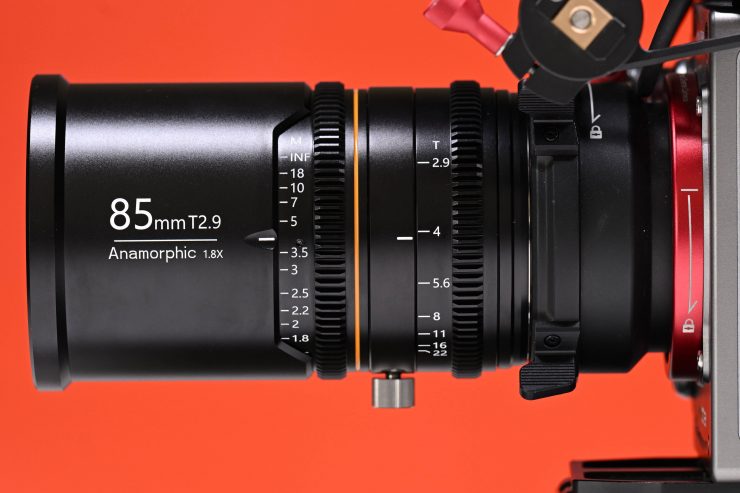
The aperture and focus rings feature industry-standard 0.8 mod cine gears. The location and position of the iris and focus gears are consistent between all three lenses which make switching a lens over easier and fast when you are running a follow focus.
The lens also features a close focusing distance of 2.35′ / 0.70 m. This is very good for a 1.8x 35mm anamorphic and it is the same as the 50mm 1.8x T2.9.
| MOD | |
| Great Joy 85mm T2.9 1.8x | 2.35′ / 0.70 m |
| Vazen 85mm T2.8 1.8x | 3.77′ / 1.15 m |
| Cooke 85mm T2.8 Anamorphic/i 1.8x Full Frame SF Macro | 7″ / 17.8cm |
Above you can see a comparison between the Great Joy and a couple of other 1.8x full frame anamorphic lenses.
Mounts
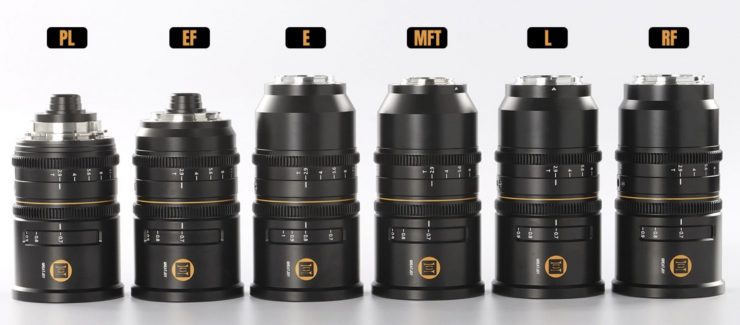
The lens is available in 6 different mounts, including PL which is nice to see for an anamorphic lens at this price point.
Why 1.8x?
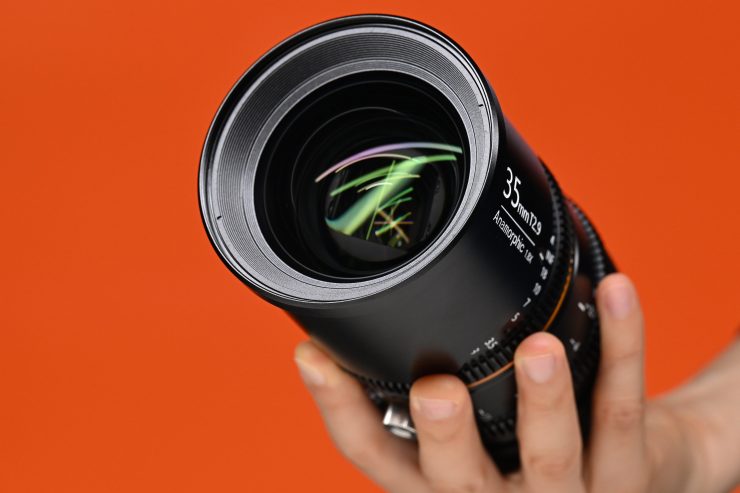
Great Joy chose to adopt a 1.8x squeeze design to balance the anamorphic characters as well as the resolution of the image. The 1.8x squeeze can produce a cinematic widescreen 2.39:1 aspect when paired up with 4:3 sensors. When paired up with 16:9 sensors, much less data (than 2X anamorphic lens) is needed to be cropped away to create the desired 2.39:1 ratio. Yes, by doing this you are cropping away information on both sides of the image, but you end up with a more acceptable aspect ratio.
Sure, you could also use the whole image and not crop to 2.39:1, but then you end up with an aspect ratio that is unsuitable for most commercial content. Great Joy did upset a few people when they released the 50mm T2.9 because they didn’t clearly state that the squeeze factor varied from around 1.68x to 1.8x depending on the focusing distance. This is not uncommon among anamorphic lenses for them to behave in his way. when I reviewed the 50mm I did all of my technical tests at the minimum focusing distance and when de-squeezing the image by 1.8x I didn’t notice any big distortion. If you are shooting someone’s face, then depending on the individual, it could have the potential to look slightly distorted. This could, of course, be easily corrected by changing the squeeze factor slightly in post.
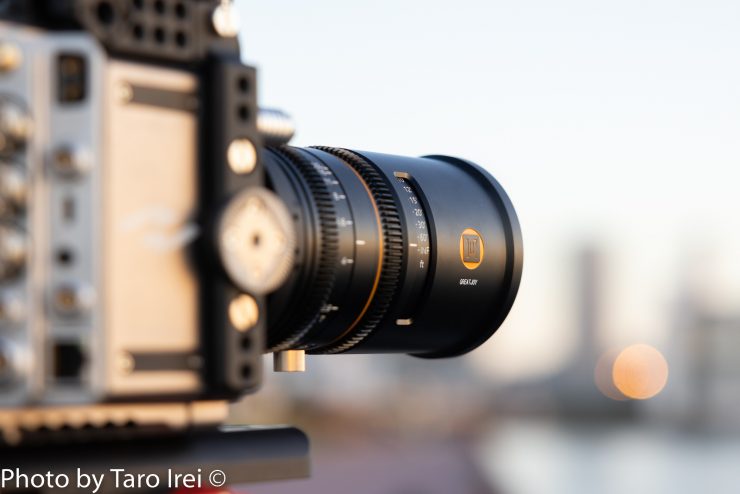
Now, Great Joy claims that the 85mm has a constant squeeze ratio. So does it? From my testing, I couldn’t see any noticeable change in the squeeze ratio regardless of what focusing distance I used.
In a lot of ways, particularly for a lens at this price, the decision to go with a 1.8x anamorphic makes a lot more sense than going with a 2x. 1.8x is more versatile and it allows the lens to be used on more cameras. I also suspect that it is also more affordable and easier to make a 1.8x anamorphic lens than a 2x. We are also now seeing a lot of anamorphic lenses being released with a 1.5x squeeze factor.
Optical Structure
The optical design of the lens consists of 18 elements in 15 groups and there are 16 aperture blades.
When I asked Great Joy about the new design for the 85mm they told me: “We’ve tried new optical structure design and new lens arrangement so there are changes in appearance and features like squeeze ratio and lens flare.”
Breathing
Anamorphic breathing appears in a different way than when using a normal spherical lens. With a spherical lens, breathing gives the appearance that the focal length is changing. However, with anamorphic lenses, vertical stretching occurs with the background. So when you adjust focus from something close to something further away, the background takes on a squeezed appearance. Hence why you see oval instead of round bokeh.
With anamorphic lenses, the more you stop the lens down, the less the out-of-focus object’s appearance will change. If you shoot wide open and pull focus the out-of-focus objects will change shape more dramatically.
Older anamorphic lenses such as Lomo’s and Kowa’s can breathe a lot. Newer anamorphic designs from companies such as Zeiss and Cooke have a lot less breathing. The popular Panavision E Series anamorphic lenses retain true anamorphic artifacts such as disproportional vertical focus breathing.
So how does the Great Joy fare?
The 85mm has some focus breathing, but it is fairly well controlled.
Above you can see focus breathing tests for the 35mm. For these tests, I was pulling focus by hand.
As another comparison, above you can see a previous test I did with the 50mm.
Fall off and Vignetting
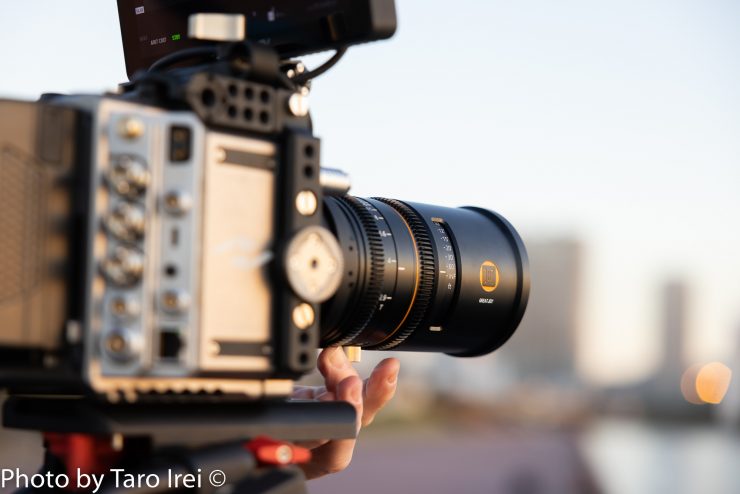
When using the 85mm I didn’t see any vignetting when I used it on the Kinefinity MAVO EDGE 6K in 6K 3:2.
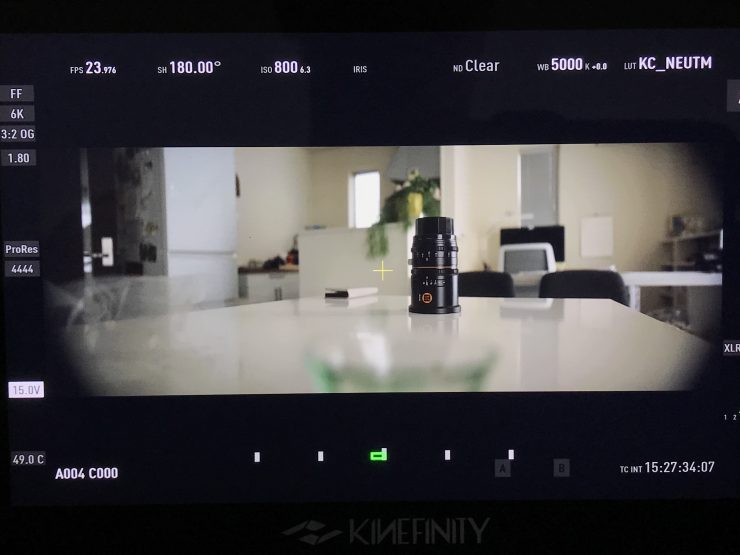
With the 35mm on a Kinefinity MAVO EDGE 6K in 6K 3:2 OG, the vignetting is a lot more prominent and noticeable, if you are cropping for 2.39:1 then you can still see some vignetting in the corners. This may be distracting and a deal breaker for some potential customers.
Sharpness
A lot of the more ‘affordable’ anamorphic options on the market tend to struggle when it comes to sharpness. In saying that, some anamorphic lenses have an inherent softness that is esthetically pleasing to a lot of DPs.
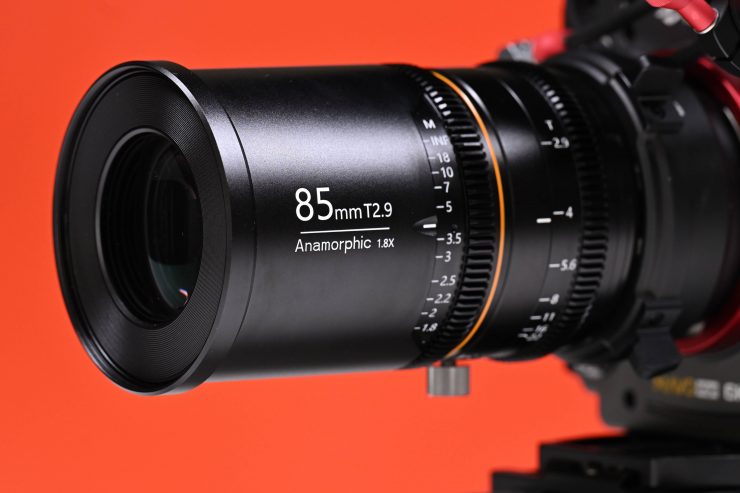
I shot a sharpness test with the 35mm on a Kinefinity MAVO Edge 6K in 6K (6016 x 3984) Open gate to see how sharp the lens was at various T stops.
The lens is a little soft when used wide open at T2.9, but the sharpness does improve quite a lot once it is stopped down to T4/5.6.
For an anamorphic lens, the sharpness is still decent, especially considering the price.
If you want a comparison, above are the sharpness tests I previously did with the 35mm and 50mm.
Lens Flare
Along with nice oval-shaped bokeh, lens flare is one of the most sort after characteristics of shooting with an anamorphic lens.
Now, because of the design and optical construction of the 85mm, the flare characteristics have changed and they are not the same as the 50mm and 35mm. The 85mm has a much more pronounced blue streak than the 35mm and it has more in common with the flare characteristics of the 50mm.
With the 35mm you get less of that horizontal streak effect. In my opinion, the flare now looks more like a mix between a spherical and an anamorphic lens. You can still get that blue streak look, but it is very subtle and only visible when you have a direct lighting source going straight down the barrel. In general, the flare characteristics of this lens are quite diffused and more subtle than a lot of other anamorphic lenses. However, you can get a lot of internal reflections bouncing off the front of the lens. Again, this is something you need to be aware of.
With the 50mm you got that typical blue streak that most people like, however, it was far softer and more esthetically pleasing than most other anamorphic lenses I have seen that are under $10K USD. Wide-open at T2.9 the blue streaks weren’t over the top and whether or not you like that look is a purely personal decision. I personally liked the lens flare and streaks I was getting with the 50mm. They had a nice softness to them, whereas with most other budget anamorphic lenses the streaks and flares can look quite artificial. Once you close down to T5.6 the blue streaks were a little more pronounced, but I did still like the results I was obtaining.
The biggest complaint people are likely to have is that the flare characteristics are not the same between the three focal lengths. The flare from the 50mm and 85mm is more synonymous with how we perceive an anamorphic lens, while the flare on the 35mm doesn’t share those same characteristics. Again, there is a lack of consistency between all of the focal lengths that you need to be aware of.
Chromatic Aberration
The lens doesn’t have any signs of visible real-world chromatic aberration, even when used wide open. You have to zoom in more than 300% to see even the tiniest amount. There also isn’t any nasty color fringing and you can see that the bokeh only has a minimal amount of color bleed. This was very impressive for an anamorphic lens at this price.
Above you can see the same test with the 35mm.
Bokeh
Nice oval-shaped bokeh is something you want if you are purchasing an anamorphic lens. The bokeh produced is reasonably pleasing, especially when used wide open.
The lens has a reasonably nice soft fall-off into out-of-focus areas. As I previously mentioned, I found that I personally preferred to create bokeh in the foreground with this lens.
As a comparison, above you can see a test done with the 35mm.
Do the lenses match?
If you are buying a set of lenses you want the lenses to all have a common look and match color-wise. So does the 85mm match the 35mm and 50mm? In short, yes and no. While it shares a similar color tone, the flare characteristics and general look of the lenses are quite different. Above you can see a comparison between the 35 and 50mm.
This is going to potentially put some buyers off, especially those who want a uniform look across the focal lengths.
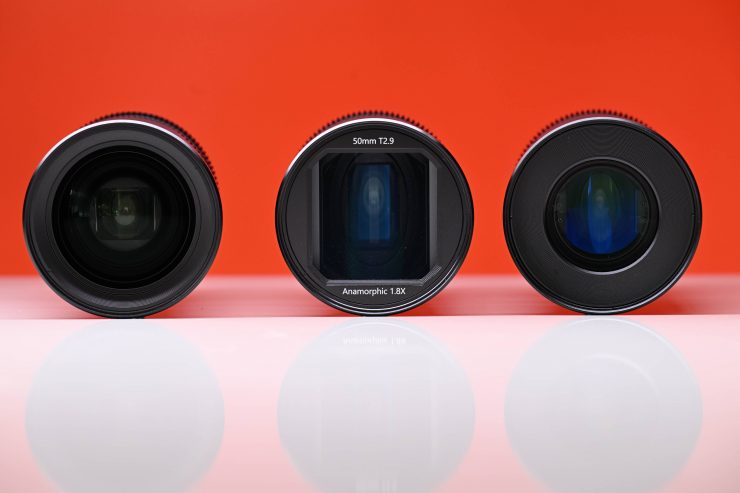
Above you can see the differences between the 85mm, 50mm, and 35mm if you look at the front of the lens.
The rear element construction is also quite different between the 85mm, 50mm, and 35mm.
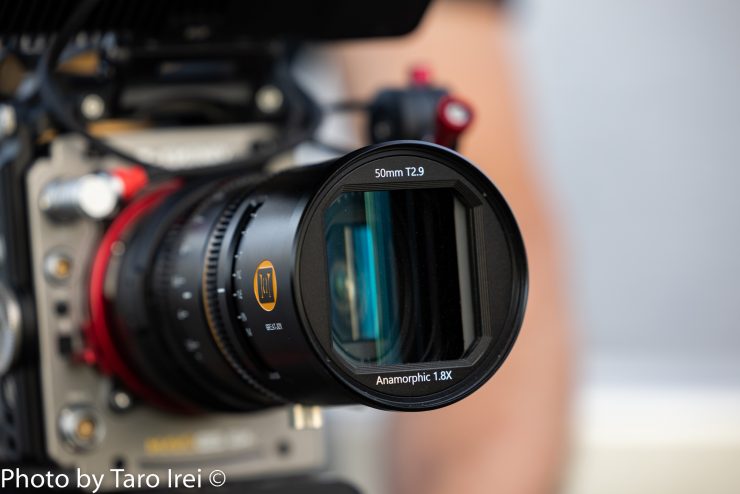
The problem with going with a new optical design on the 85mm and 35mm is that you end up with lenses that don’t share all of the same characteristics. The only way to rectify this issue is that Great Joy would have to redesign the 50mm. When I asked them about this I was told: “For the time being, we do not intend to update the 50mm design. Currently, we are focusing on the production of the 35mm, and developing the 135mm as well. However, we are not ruling out upgrading the 50mm version in the near future.”
Color Tone & Personality
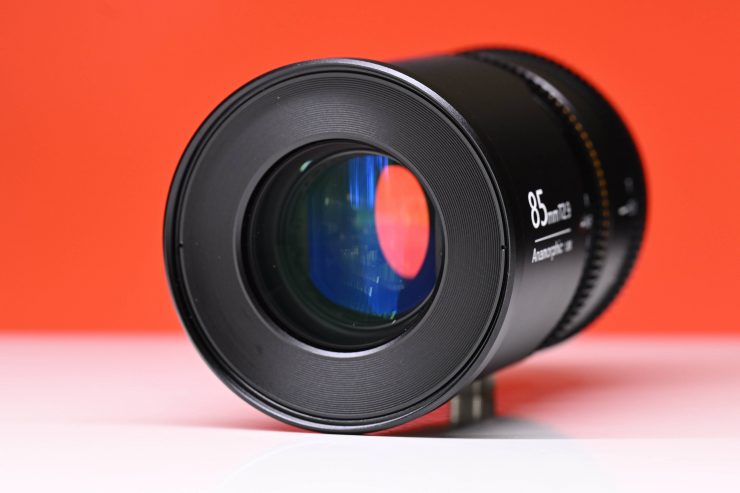
The lens is fairly neutral when it comes to color, however, I thought it leaned slightly warm. In terms of its personality, it has a nice amount of character.
I quite like the look of the lens, but again, this is just my personal opinion.
Real World Thoughts
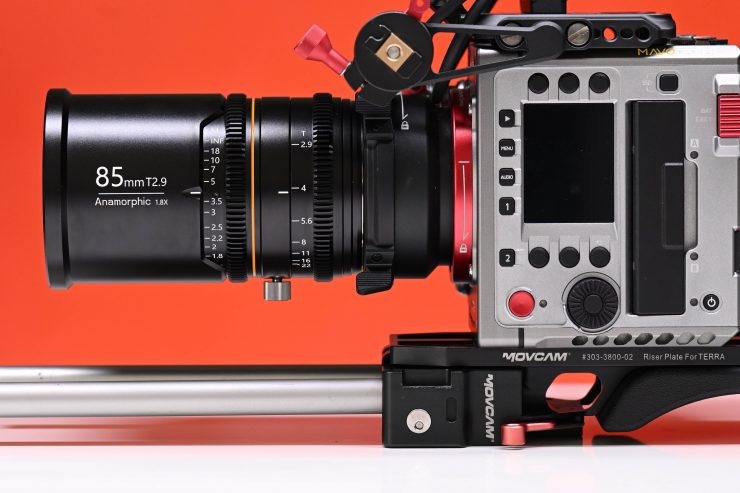
The lens is easier to use and operate than the 35 and the 50mm. I liked the images I was getting from it. Optically it is reasonably sharp as far as anamorphic lenses go, and it has some nice character. The lens is relatively compact given the image sensors it covers and it works well on a wide array of cameras.
I wanted to see what the 85mm looked like in the real world, so I went and grabbed a few shots.
Above you can see images shot with the 85mm T2.9.
As a comparison, above you can see footage taken with both the 35mm and 50mm. This was all shot in 6K 3:2 pen Gate on the Kinefinity MAVO 6K EDGE. The grade I have done is quite stylized and it may not be to everyone’s tastes.
What I noticed is that while the lenses still look reasonably similar when shooting in the real world, the flare characteristics are completely different and the squeeze factor remains the same across the focus range on the 35mm and 85mm, while on the 50mm it doesn’t.
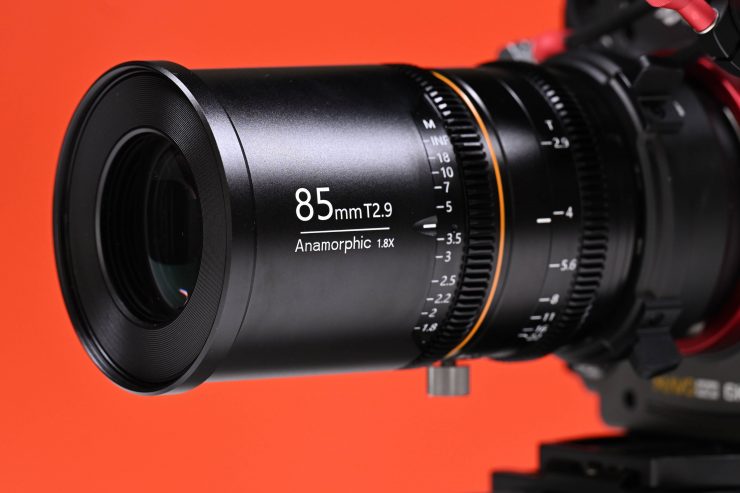
For me, an anamorphic lens is more about flares and bokeh, and they can be used as an option when shooting lots of different types of projects and you can also mix them in with spherical lenses.
More Focal Lengths Coming
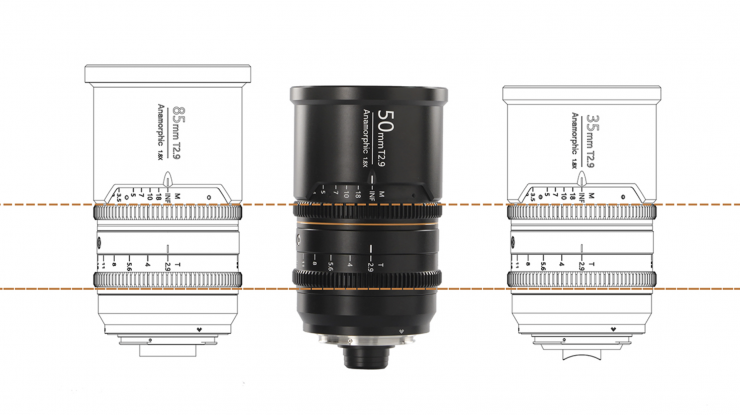
As I previously mentioned, the 85mm now joins the 35mm and 50mm. The company is also working on a 135mm.
I’m going to play the devil’s advocate for a second here and state that I personally think it makes a lot more sense to launch lenses once you have a set available. Although, in saying that, Great Joy has brought out the 35mm and 85mm fairly quickly after releasing the 50mm.
Price & Availability
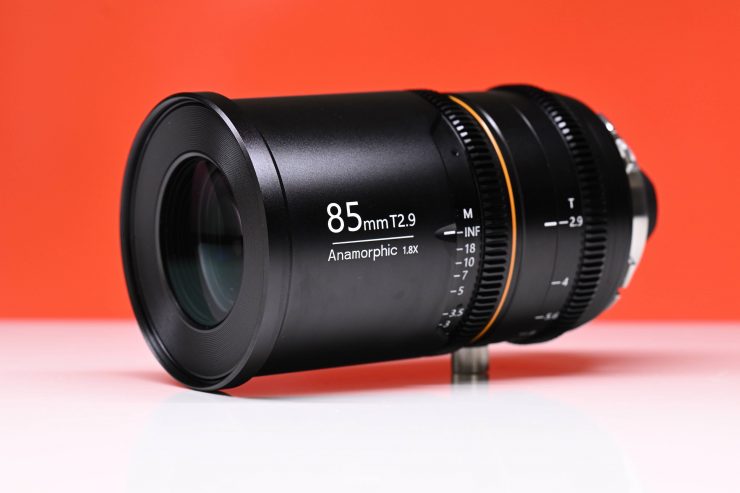
The 85mm 1.8x T2.9 has been launched on Indiegogo. Great Joy has a few launch day specials and I have also included other early bird offers and the recommended retail price once the Indiegogo campaign is over.
| PL (comes with EF adapter) | E/RF/MTF/L | |
| Launch Day Special | $1,445 USD | $1,189 USD |
| VIP Exclusive | $1,445 USD | $1,189 USD |
| Super Early Bird | $1,495 USD | $1,229 USD |
| Early Bird | $1,529 USD | $1,259USD |
| Indiegogo Special | $1,614 USD | $1,329 USD |
| RRP | $1,699 USD | $1,399 USD |
Great Joy officially launched the lens on the 6th of December.
| PRICE | |
| 35+85mm PL/EF Bundle | $2,890 USD |
| 35+85mm E/RF/MTF/L Bundle | $2,378 USD |
| 50+85mm PL/EF Bundle | $2,890 USD |
| 50+85mm E/RF/MTF/L Bundle | $2,378 USD |
| 35+50+85mm PL/EF Bundle | $4,335 USD |
| 35+50+85mm E/RF/MTF/L Bundle | $3,567 USD |
| Hard carrying Case Super Early Bird | $139 USD |
| Hard Carrying Case Retail | $199 USD |
Great Joy also has some bundle deals which you can see above.
Competition?
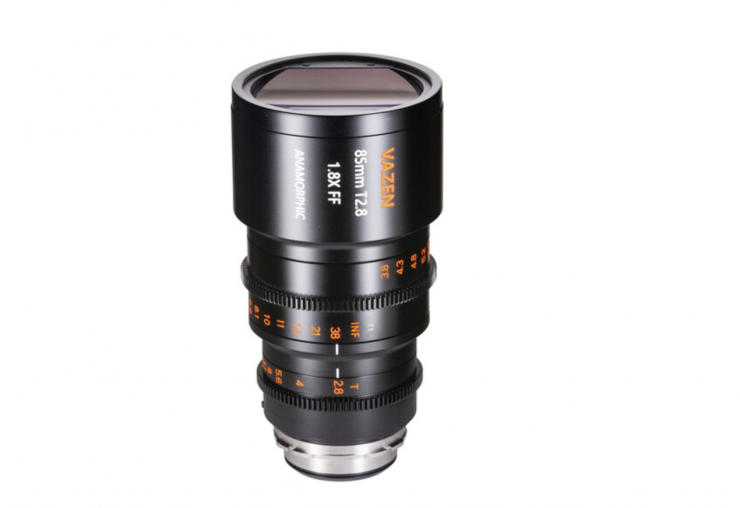
There isn’t really that much competition when it comes to 1.8x full frame anamorphic with a focal length of around 85mm. Essentially, the only competition comes in the form of the Vazen 85mm T2.8 1.8x Full-Frame Anamorphic Lens ($6,999 USD) and the Cooke 85mm T2.8 Anamorphic/i 1.8x Full Frame SF Macro ($38,800 USD).
Do you really need an anamorphic lens?
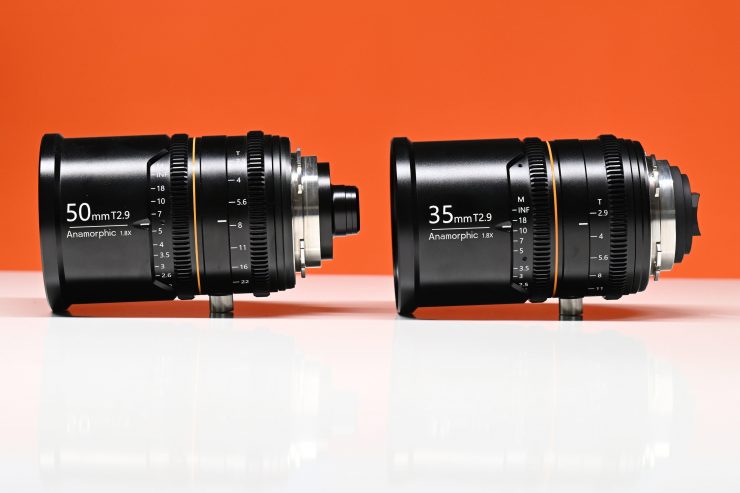
I think in principle a lot of people like the idea of shooting with anamorphic lenses, but whether or not you actually need to may be a completely different story. Depending on what you do there may well be little to no demand to shoot anamorphic. For a lot of shooters, it makes more sense to rent anamorphic lenses rather than to own them, however, with quite a few budget-friendly options now on the market, they are affordable enough to purchase.
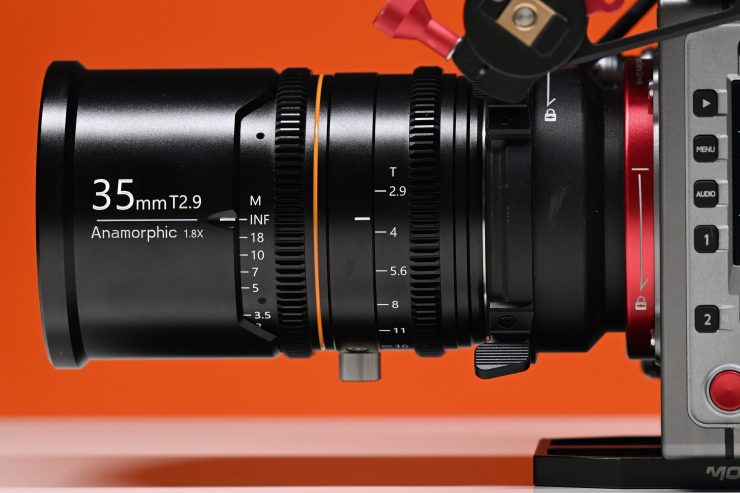
While you may find the look of anamorphic esthetically pleasing, a lot of shows will not shoot anamorphic if they are going on broadcast television, simply because the broadcasters don’t want viewers complaining about black bars on top and below the image. With more and more online content being created by Netflix, Amazon, Disney, etc. this isn’t really an issue. Online streaming entities are often more than happy to have productions shoot with anamorphic lenses. If you produce content that will end up in a widescreen aspect ratio you could easily mix anamorphic and other spherical lenses together. Also if you are making your own content then go for your life and use whatever you like.
In my honest opinion, it is usually better to just rent good anamorphic lenses for projects that require them. Although, in saying that, buying affordable anamorphic lenses makes sense if you are someone who is going to use them a lot for the type of work you do.
Conclusion
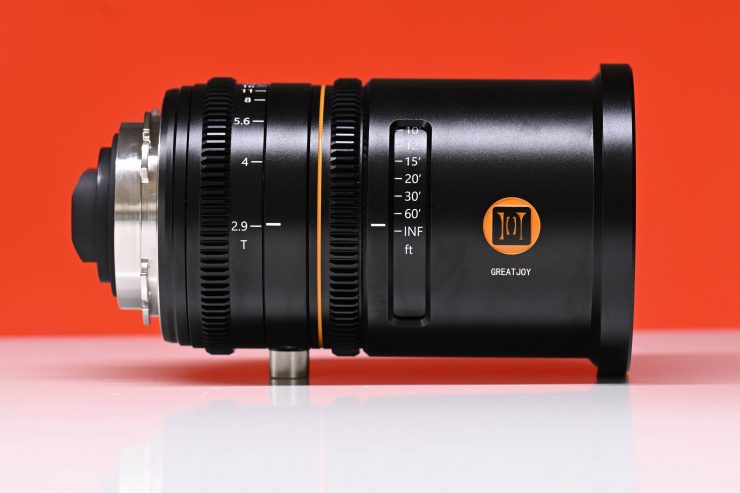
Great Joy’s first lens, the 50mm 1.8x T2.9 surprised me in a good way, despite some of its flaws. The 85mm and the 35mm 1.8x T2.9 follow in those same footsteps but both improved on a lot of the shortcomings of the 50mm. The lenses are ridiculously cheap for what they are, and furthermore, at this price point, they don’t have any real direct competition.
In the past, I have generally been pretty disappointed with most so-called ‘affordable’ anamorphic lenses. The only decent full-frame offerings that have a 1.8x squeeze that I would consider ‘affordable’ were the Vazen which are still $8000 USD each, however, Vazen doesn’t make anything wider than a 50mm.
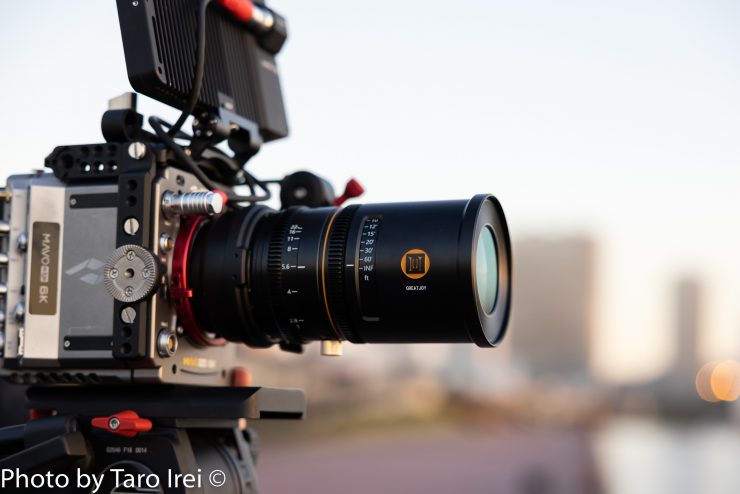
Great Joy continues to surprise me and even though I had my doubts before reviewing their 50mm that you get a decent full-frame 1.8x anamorphic in PL mount for under $1,400 USD, I was happy to be proved wrong.
The 85mm, just like the 35mm, has much-improved mechanics, and it is good to see a company listening to user feedback. The 85mm is reasonably sharp for an anamorphic lens that is this wide, and I do like the look of the lens, even though it isn’t going to resemble most other anamorphic offerings.
Anamorphic lenses are hard to review. Sure, I can talk about the technical aspects of a lens, but technical perfection is not what most DPs look for when choosing an anamorphic. The character and unique look of a lens are why certain anamorphic lenses are more popular than others. Unless you are after something that is super clean like an ARRI Master Anamorphic, the preference is usually to find and use a lens that has lots of character.
In the past, anamorphic lenses were predominantly rental items for a lot of shooters, simply because the cost of ownership was so high. Now, with more affordable options coming to market I can see more and more people starting to purchase them.
Lenses can have different characteristics when used on different cameras and it is important to try out both the lens you want on the camera or cameras you own or use.
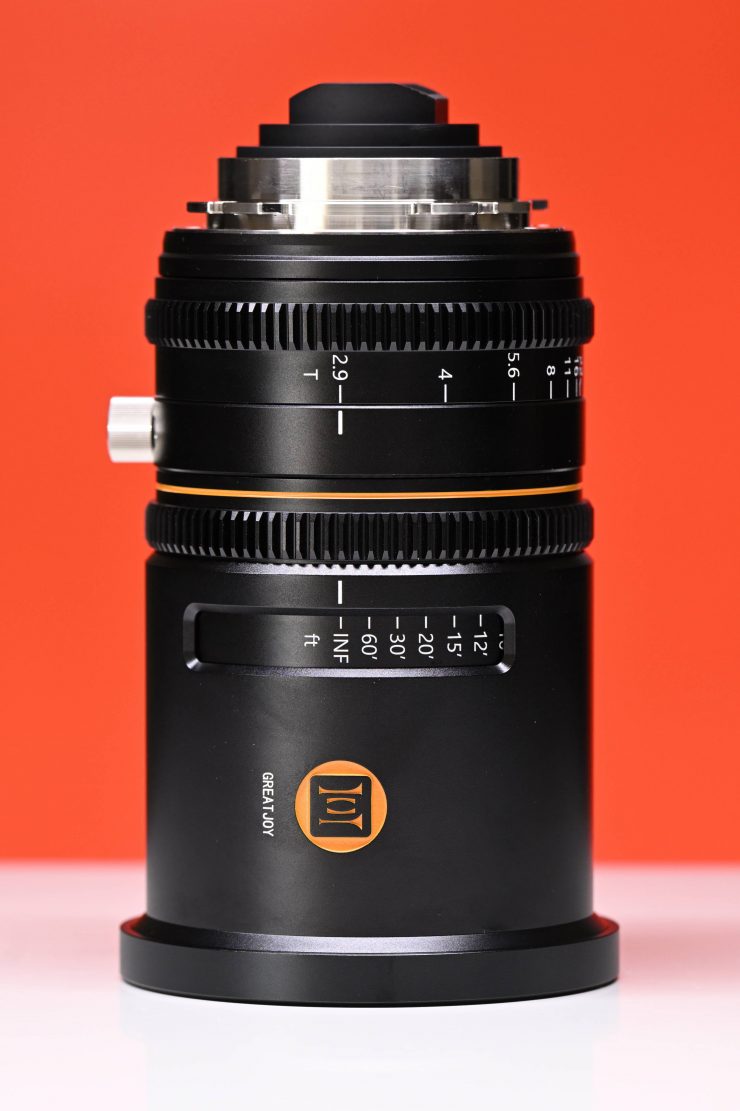
The Great Joy 85mm T2.9 1.8x Anamorphic, just like the 35mm and 50mm, isn’t optically perfect, but that’s what gives it its character. I personally like the look of the lens and it certainly ticks a lot of boxes if you are looking for a very cost-effective anamorphic solution. The biggest complaint is that it doesn’t match the existing 35mm and 50mm when it comes to lens flare and the characteristics of the look.
In saying that, the lens still strikes a very good balance between affordability, image quality, and usability. Companies like Great Joy are certainly filling a gap in the market that previously didn’t exist. It is nice to see that there are now three focal lengths that you can purchase without having to spend a ton of money.

